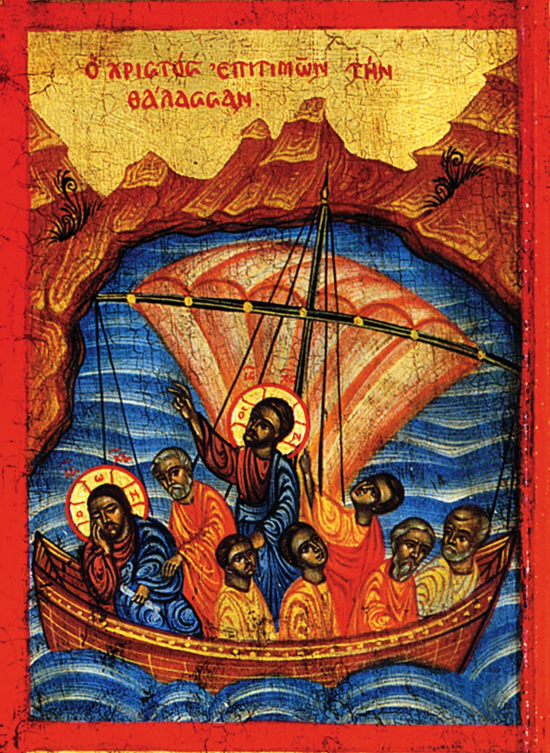Conqueror of Sea and Storm
Twelfth Sunday Scripture Readings

Unfortunately, it’s impossible to uncover the historical details of the event described in today’s gospel. Like any archeological investigation, we need to come prepared to investigate layer after layer of meaning. We always hope that we’ll at least be able to uncover the outlines of the reality underlying it all. In this case, we can only surmise that Jesus was with certain of his disciples—many of whom were fishermen—on the Sea of Galilee when a storm arose. Jesus seemed to them to have exercised a certain power over the storm. Whatever that looked like to them, they came away impressed enough to include versions of the story in all four gospels and continued to apply the lessons they learned from the experience to their ministry after the Resurrection. Keep in mind that, as always, the disciples and evangelists were forever looking for the spiritual lessons behind every word and action of Jesus.
One lesson they took away from this story as told by the eyewitnesses was an encounter with the saving power of God manifested in the person of Jesus. The disciples, after all, had been told that they would be “fishers of men.” [Mark 1:17] After Pentecost, they saw themselves as casting the net of salvation into the perilous waters and drawing all people into the safety of the boat with them. The meaning there is obvious: that God, in the person of Jesus, is more powerful than any danger that his followers in the safety of the boat of the Church could encounter. The message is one of encouragement, for all that is necessary for his followers is to trust in God, for “miracle” is our word for what Jesus called a sign or manifestation of God’s power.
Hidden even more deeply in this story lies a proclamation of the identity of Jesus. Not only the boat is given a symbolic meaning. The beliefs of the Assyrians and Babylonians seeped into the Hebrew culture in the same way the beliefs of the Romans and Greeks did in ours. Even though we no longer believe that stars are gods, we still have poems and songs about wishing upon a star. So, take the sea itself in the gospel as an example. In the Babylonian creation story, the primeval waters of chaos were called Tiamat—a water-monster who was conquered by the gods of creation. She was cut in half to make the waters in the heavens and under the earth. Remnants of this story can be found in the Hebrew creation story, only stripped of divinity, as the breath of God—God’s Spirit—breathed on the waters of chaos and as God divided the waters below the firmament from the waters above. In nearly all belief systems of the Middle East, from Syria down to Egypt, the Creator God was the power who brought order out of chaos. Evil was seen as the force that sought to return creation into chaos. The waters of the Sea of Galilee on which the boat was tossed were not only dark and mysterious, but they were also dangerous and threatening.
Now, look at the image of the storm. It, too, had subconscious implications for the gospel writers. Throughout the Middle East, the storm god, Hadad, was addressed as Ba’al, meaning “lord.” One of Ba’al’s titles was “he who rides on the storm.” Notice that the Greek god, Zeus, and the Roman god, Jupiter, both hurled thunderbolts. They, too, were storm gods. So, once again, in the gospel, we’re put under the influence of a chaotic power. We read that Jesus “rebuked” the storm. That’s the term that the gospel uses to describe how Jesus overcame demons and cast them out of those who were possessed. Here, the power of God is summoned to overcome the powers of chaos.
These allusions take us a long way around to a simple message, but nobody ever accused the peoples of the Middle East of being simple and straightforward. At the same time, we have to wonder if our simplistic, so-called “scientific” approach could do any better at uncovering deeper spiritual truths. In any event, we see here that Yahweh, the God and Father of our Lord, Jesus Christ, is He who overcomes every negative element in his creation, bringing order out of chaos, reversing entropy, canceling destructive forces, and vanquishing evil. The God who is God brings to nothing those forces of nature and the forces of evil that only appear to have divine power. “Who then is this, whom even the wind and sea obey?” Jesus, the rebuker of wind and wave, is presented to us as the conqueror of Tiamat and Ba’al.
The lesson of today’s gospel is therefore four-fold. First, that our God is a saving God who overcomes all evil. Second, that the full force and power of God is present in Jesus the Messiah. Third, that Jesus is alive and powerful in the community of believers, the Church. And, finally, that power which is capable of overcoming any evil, is available to us as a Church and as individuals if only we can let go of the temptation to take control or to panic, and simply trust God. This means much more than simply giving lip service to faith, but rather placing our trust in word and deed in Immanuel—God with us.
Jesus speaks to us as he spoke to his disciples, not only in this instance but time and time again in the gospels, asking, “Why are you terrified? Do you not yet have faith?”
Get articles from H. Les Brown delivered to your email inbox.
